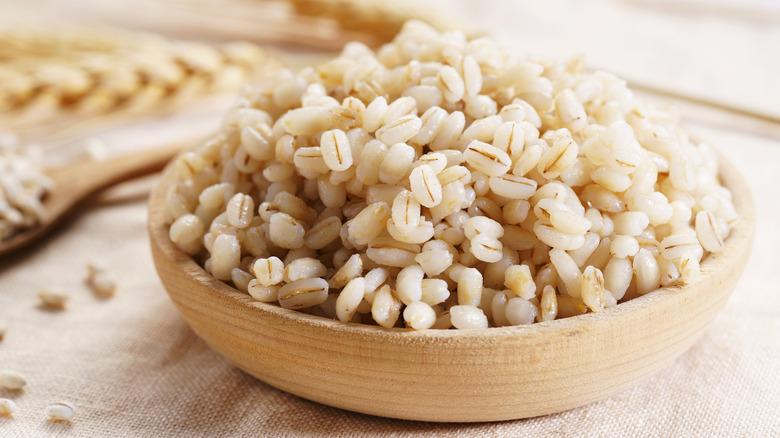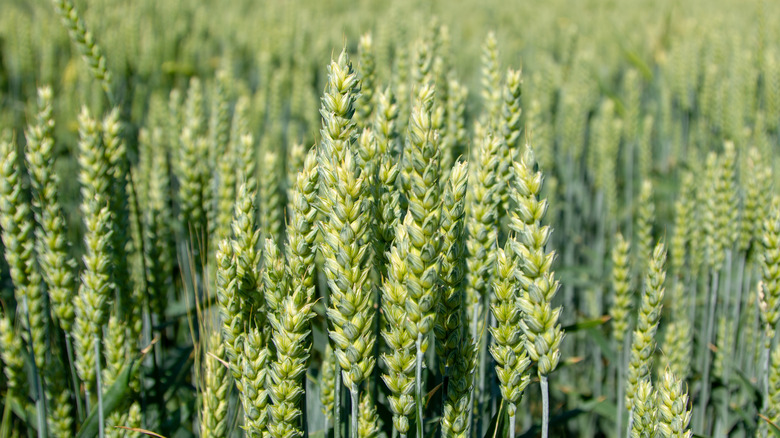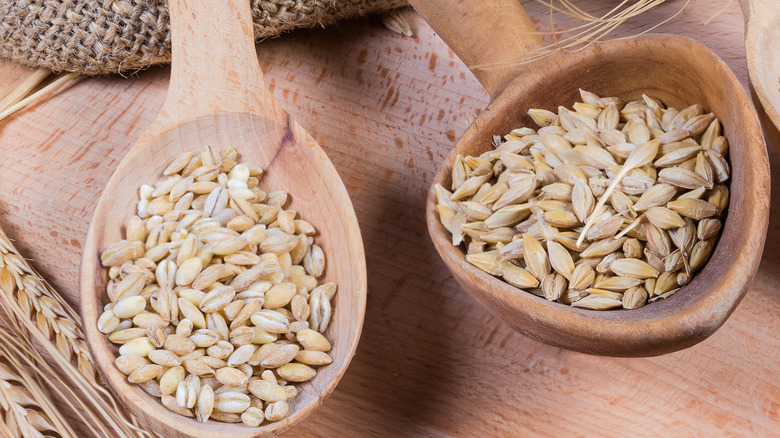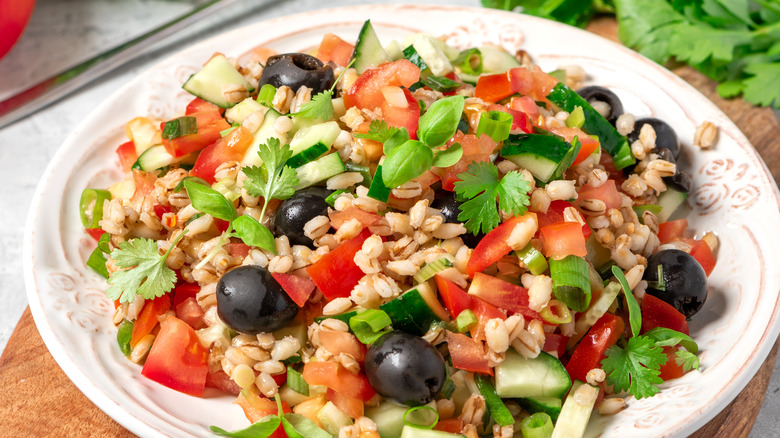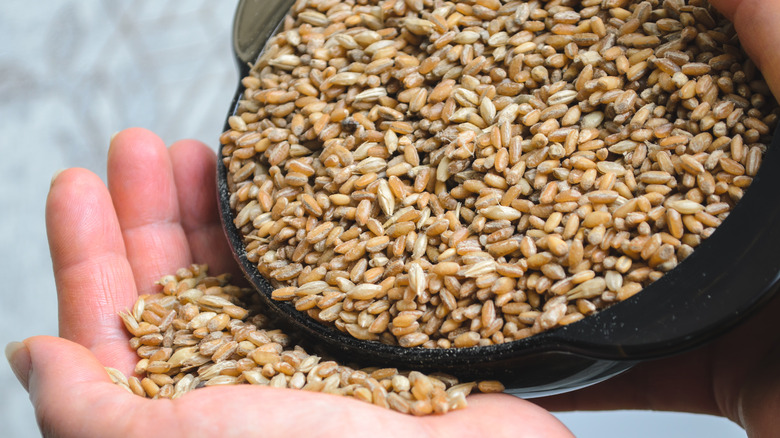The Difference Between Pearled And Hulled Barley
There you are, at the store to get what you need for your recipe, and on the list is "barley." It seems a simple enough task, until you see two kinds of barley on the shelf. Hulled or pearled: What do those words even mean, and will your recipe be ruined if you choose the wrong barley? Here's what you need to know about these two varieties of nutritious barley, and how you can use them in your cooking.
Barley kernels are available either hulled or pearled. The Whole Grains Council says that hulled barley is a whole grain, because it's minimally processed to remove the hull from around the kernel. Pearled barley goes through additional processing to remove the bran as well, and after this it's no longer considered a whole grain. Barley can be purchased in other forms too, such as flour, grits, and flakes. However, The Kitchn notes that hulled and pearled barley are the most familiar forms, used in recipes for beef and barley soup, cold salads, and can even be used to create barley risottos.
What is barley?
MasterClass describes barley as a cereal grass similar to wheat. Because barley can grow in a variety of climates, this ancient grain has been cultivated across the globe for thousands of years. According to Huffington Post, barley is just as deserving of the "superfoods" label as more trendy grains like quinoa and freekeh. It's packed with healthful nutrients, protein, fiber, and best of all, barley is easy to find in stores and is fairly inexpensive. It has a delicious texture and flavor all on its own, but can also be used as the foundation for recipes in much the same way as rice. Barley has a multitude of other uses in cooking, as MasterClass shares. The grain is used to make breads, stews, as a sweetener, and can be malted to make beer and whiskey.
Barley sold in stores, according to The Kitchn, is typically labeled as hulled or pearled. When barley is harvested, it has an inedible covering called a hull. Hulled barley means that the grains are processed just enough to remove this hull, and the bran layer remains. Hulled barley is more nutritious with this bran, but also takes longer to cook.
Pearled barley goes through additional processing to strip away most or all of the bran layer. The pearled barley grains are less tough and cook faster, but are no longer whole grains. (Pearled barley and pearl barley are the same thing; "pearling" means polishing the grains to remove the bran.)
How to tell if your barley is pearled or hulled
In some cases, you might be able to tell whether you're getting hulled or pearled by looking at the barley in the package. The Whole Grains Council says that the process of pearling the grains, depending on how much of the bran is removed, could leave the barley looking almost white. If your barley looks like this, then it's a safe bet it's pearled. However, sometimes the pearling process intentionally leaves part of the bran layer behind. Bob's Red Mill shares that this is a way for the grains to retain more of the valuable nutrients. Barley that's only lightly pearled will be light brown grains that unfortunately don't look strikingly different from hulled barley.
If your bag of barley doesn't specify hulled or pearled (most do, but there are a few brands that just say "barley"), another way you can tell is by looking at the cooking time specified on the package. The Kitchn shares that hulled barley with its intact layer of bran takes longer to cook — close to an hour. Pearled barley grains are softer, and need only about 25 to 30 minutes to become tender.
How to cook barley
Before you begin cooking barley, know that some sources like Reader's Digest say that barley should be rinsed first. This is recommended to remove any debris that may have wound up mixed in with the grains. Also, with cooked grains and rice in general, rinsing can make the grains less sticky. However, many recipes for barley don't call for this step, so you can make the choice to rinse the barley first or just dive in.
The Kitchn says to combine barley — hulled or pearled — with twice as much water in a pan with a pinch of salt. Bring it to a boil, and monitor the barley so that foam created by the cooking grains doesn't escape the pan. Turn the heat down to low and cover the pan. Cook the barley until tender, which should take around a half hour for pearled barley, or 45 minutes to an hour for hulled barley. Any water that's left can be drained away. One cup of uncooked barley will yield three cups of cooked barley.
The Kitchn shares that barley can also be cooked in the liquid of soups or other recipes, and the grains will do double duty of being delicious and of thickening the dish for you. If you're using cooked barley in a cold dish, as in Martha Stewart's Mushroom Barley Salad, let the barley cool before tossing it with other ingredients.
Can you substitute hulled barley for pearled? Or vice versa?
Both pearled and hulled barley have a nutty flavor and chewy texture, and they're both delicious in so many recipes. Hulled barley has the advantage of being a whole grain, since the bran is intact, and according to Whole Grain Council it's the barley to reach for if you want the most nutritional value possible. However, they point out that pearled barley is still a very healthy grain, especially when compared to other, heavily processed grains. Some pearled barley retains part of the bran layer by only lightly pearling the grains. The Whole Grain Council shares that even heavily pearled barley still has plenty of fiber.
As far as your cooking, it is okay to substitute one type of barley for the other, as long as you adjust the cooking times. The Kitchn notes that hulled barley is tougher and needs a longer cooking time; almost an hour. If you are substituting hulled barley for pearled barley in a recipe (and The Kitchn says that most recipes are based on using pearled), plan to add 20 to 25 minutes of extra cooking time. Add in a little extra water if it's getting low before the grains are tender.
